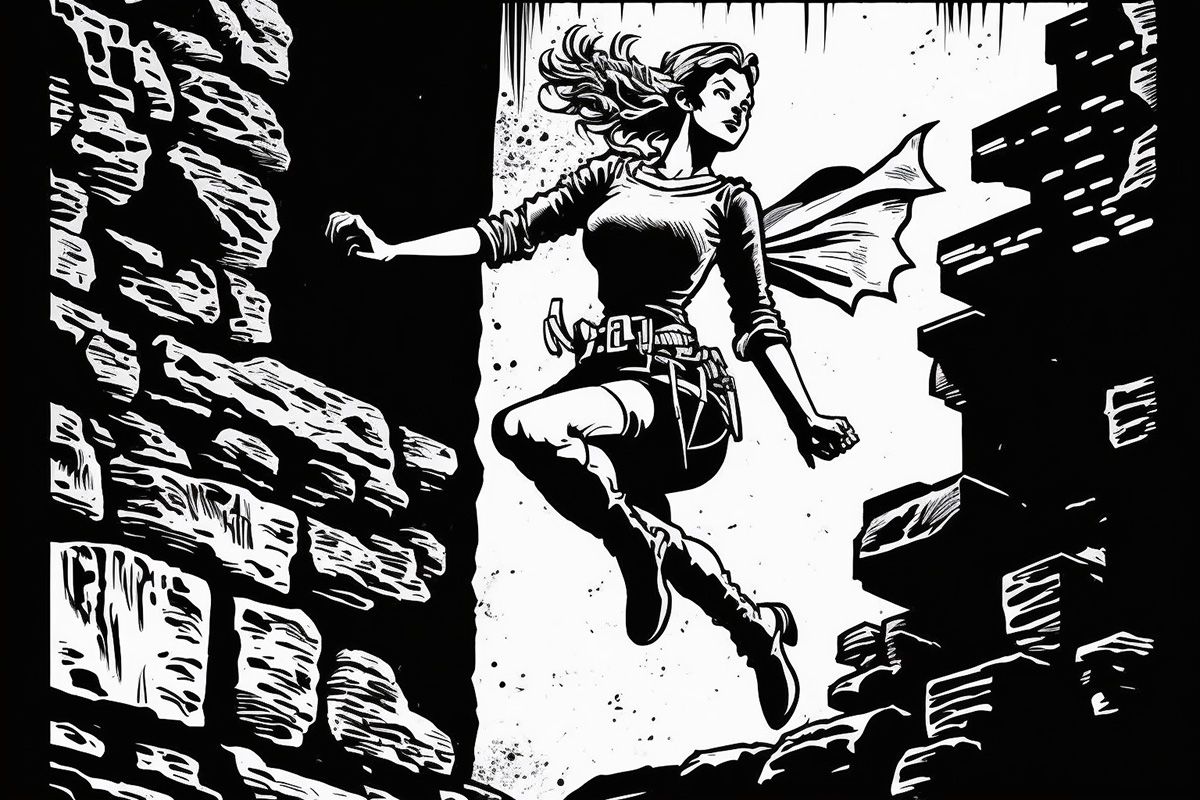Apart from the usual dragons, explosions and the odd gelatinous cube, it’s not uncommon for adventurers to find themselves in precarious situations, including the occasional unintended plunge from great heights. Feather Fall is a vital spell that can turn a potentially disastrous fall into a gentle descent, saving characters from serious harm.
While Feather Fall may seem straightforward at first glance, a deeper understanding of its mechanics and applications can significantly enhance a spellcaster’s ability to make the most of this versatile spell. We’ll delve into the intricacies of Feather Fall, answering common questions and providing insight into its effective use in various situations. Whether you’re a seasoned spellcaster or new to the arcane arts, this comprehensive guide to Feather Fall will ensure you’re well-prepared to handle even the most treacherous of falls!
Table of Contents
What does the Feather Fall spell do?
Feather Fall is a 1st-level transmutation spell that grants a controlled descent for up to five creatures, causing them to fall slowly as if drifting gently to the ground on a cushion of air. When cast, the affected creatures’ rate of descent is reduced to 60 feet per round, allowing them to glide safely to the ground, landing on their feet and avoiding the devastating effects of a high-speed impact. The magical effect lasts for the entire duration of the fall or until the spell’s duration expires.
What can Feather Fall be used for?
Feather Fall is a versatile spell with a wide range of applications, making it an invaluable addition to any spellcaster’s arsenal. Some common uses and situations for the spell include:
- Saving party members or NPCs from unintentional falls, such as during combat on precarious terrain or when traversing a rickety bridge.
- Providing a controlled descent from great heights, enabling the party to bypass dangerous obstacles or access hard-to-reach locations.
- Escaping a pursuing enemy by leaping from a high vantage point and floating safely to the ground.
- Performing daring acrobatics or stunts during social encounters, allowing the spellcaster to make a dramatic entrance or impress a crowd.
- Mitigating the risk of falling during aerial combat or when traversing vertical environments, such as climbing a cliff face or scaling a tall tower.
By understanding the various situations in which Feather Fall can be employed, spellcasters can use this spell to its full potential, turning a potential disaster into a strategic advantage.

How does Feather Fall work?
Spellcasting requirements
Components: Feather Fall requires a verbal component and a material component, which is a small feather or a piece of down. This means that the spellcaster must be able to speak and have access to the required material to cast the spell. The material component is not consumed during casting and is considered to be contained in the standard components pouch.
Casting time: Feather Fall has a casting time of one reaction, which can be taken in response to an event or a specific trigger, such as witnessing a creature falling. This swift casting time allows the spellcaster to react quickly to save themselves or others from imminent harm.
Target selection and range
Feather Fall can target up to five creatures within 60 feet. The spellcaster can choose which creatures within range are affected, making it possible to save multiple allies or strategically affect enemies. However, the spell must be cast on creatures that are falling, and it has no effect on creatures that are not in the process of falling.
Duration and effect on falling speed
Once cast, Feather Fall lasts for one minute (10 rounds in combat time), or until the affected creatures reach the ground, whichever comes first. While under the effects of the spell, the targeted creatures’ rate of descent is slowed to 60 feet per round, allowing them to gently float to the ground without taking any fall damage. This controlled descent grants ample time for affected creatures to reposition themselves, react to new threats, or make additional plans before reaching the ground.
How do you use Feather Fall?
Identify the trigger: Feather Fall is cast as a reaction, so the spellcaster must identify a valid trigger to cast the spell, such as seeing an ally or themselves start to fall from a height.
Confirm range and targets: The spellcaster must ensure that the chosen targets are within the 60-foot range and that no more than five creatures are targeted. Remember that the spell only affects creatures that are currently falling.
Fulfil spellcasting requirements: The spellcaster must be able to speak (to provide the verbal component) and have access to the required material component (a small feather or piece of down), usually within the standard components pouch.
Cast the spell: Upon casting, Feather Fall will take effect immediately, slowing the targeted creatures’ descent to 60 feet per round for up to one minute or until they reach the ground.
Tips for using Feather Fall effectively in-game
- Stay aware of your surroundings: Pay attention to the terrain and environment during combat or exploration, as well as the position of your allies and enemies. This will allow you to quickly react to potential falling hazards.
- Communicate with your party: Let your party members know that you have Feather Fall prepared, this way they can take calculated risks with the knowledge that you can save them from falling.
- Consider creative applications: You don’t have to limit yourself to using Feather Fall only as a safety net! Why not try to think of innovative ways to use the spell, such as accessing hard-to-reach areas or making a daring escape from a dangerous situation?
Does Feather Fall stop all fall damage?
Yes, if the create lands while the Feather Fall spell is active it will stop all fall damage by slowing the descent to 60 feet per found and the creature will even land on its feet to boot! As Feather Falls lasts one minute (10 rounds), it would be a rare occurrence you would be falling longer than this. However, if the spell does expire, the creature will start calculating fall damage (and fall speed) normally from that point.
It’s also worth noting that surprised, unconscious or incapacitated players cannot cast Feather Fall, therefore, if a spellcaster finds themselves in such a state while falling, they will be unable to cast the spell and will suffer fall damage as usual.
The other thing to note is that Feather Fall does not prevent damage from forced movement or collisions with objects during the fall. If a creature is pushed, teleported, or otherwise forced into a collision while under the effects of Feather Fall, it may still take damage from the impact, depending on the circumstances and the DM’s discretion.
How far can you fall with Feather Fall?
Feather Fall reduces the rate of descent to 60 feet per round for the affected creatures, and the spell lasts for one minute, which is equal to 10 rounds in combat time. To calculate the maximum distance a creature can fall while under the effects of Feather Fall, we can do some simple maths and multiply the rate of descent by the duration in rounds:
60 feet per round × 10 rounds = 600 feet is the maximum distance you can fall with Feather Fall.
Factors affecting the distance
While the maximum distance fallen during the spell’s duration is 600 feet, several factors can affect the actual distance a creature falls:
Height of the fall: If the height from which a creature falls is less than 600 feet, it will reach the ground before the spell’s duration expires. In this case, the actual distance fallen is equal to the height of the fall.
Movement during the fall: If a creature can move horizontally while falling, such as with a fly speed or other abilities, they may cover additional distance before reaching the ground. This movement should be considered separately from the vertical distance covered by Feather Fall.
Interruptions to the fall: If the fall is interrupted by obstacles or other factors, such as a creature grabbing onto a ledge or being caught by an ally, the actual distance fallen may be less than the maximum allowed by the spell.
Is Feather Fall a concentration spell?
Feather Fall is not a concentration spell, which means that it does not require the spellcaster to maintain focus on the spell for it to remain in effect. This allows the caster to potentially cast other concentration spells concurrently with Feather Fall, providing greater versatility in their spellcasting options during combat or exploration. The absence of concentration also means that the spellcaster does not risk losing the effects of Feather Fall due to taking damage or failing a Constitution saving throw.
Is Feather Fall a good spell?
Feather Fall is widely considered a good spell due to its versatility, utility, and lifesaving potential. As a 1st-level spell, it is accessible to spellcasters early in their adventuring careers, providing a valuable safety measure for a variety of situations, especially as falls for low-level players can be absolutely lethal. By negating fall damage and offering a controlled descent, Feather Fall can be a game-changer in both combat and exploration scenarios.
Feather Fall compared to other defensive spells
While there are other defensive spells available to spellcasters, Feather Fall occupies a unique niche in addressing the specific danger of falling. Other spells, such as Shield, Mage Armor, or Absorb Elements, focus on improving a character’s defences or reducing damage from different sources. Feather Fall, on the other hand, addresses a unique environmental hazard and can turn a potentially lethal situation into a strategic advantage.
Situational advantages and disadvantages of Feather Fall
As with any spell, Feather Fall has its situational advantages and disadvantages. Some of these include:
Advantages of Feather Fall:
- Lifesaving potential: Feather Fall can save characters from taking significant damage or even dying from a fall, making it a critical tool for survival.
- Quick casting time: With a casting time of one reaction, Feather Fall can be cast quickly in response to a trigger, allowing the spellcaster to react swiftly to sudden threats.
- Multi-target capability: The ability to target up to five creatures within range adds to the spell’s versatility and utility in group situations.
Disadvantages of Feather Fall:
- Limited application: Feather Fall is a highly specialised spell that specifically addresses falling hazards. In situations where falling is not a concern, the spell may be less useful compared to other defensive spells.
- Opportunity cost: As a 1st-level spell, preparing Feather Fall may require the spellcaster to forego other potentially useful spells in their limited repertoire.
Despite its situational disadvantages, Feather Fall remains a valuable addition to any spellcaster’s arsenal. The key to making the most of this spell lies in understanding its mechanics, recognising opportunities for its use, and creatively applying it in various situations.
Should you take Feather Fall?
While Feather Fall may not be the most flashy or offensive spell in a spellcaster’s arsenal, its ability to save lives and create unique opportunities for strategic gameplay makes it a valuable asset in the unpredictable world of DnD. Whether you are a seasoned adventurer or just starting your journey into the arcane arts, Feather Fall is a spell that should not be underestimated. With the knowledge and insight provided in this article, you are now well-prepared to handle even the most treacherous falls and turn potential disasters into opportunities for triumph!
